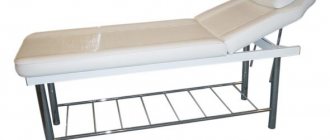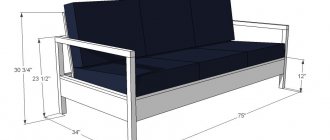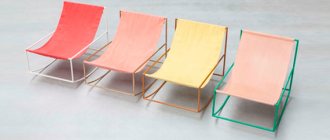Despite the abundance of various furniture in stores, a simple stool has been and remains a fairly popular piece of furniture in the home. It is especially relevant if the apartment is decorated in a rustic style - in a kitchen with such a design, an ordinary stool will be simply irreplaceable.
But it’s not easy to buy a quality product now, so it’s easier to make it yourself. How to make a stool with your own hands from wood? The drawing, diagram and step-by-step instructions are in this material.
How to make a stool with your own hands from wood
Types of stools
Stools or chairs without legs come in different types. A limited number of models are sold in furniture stores. In turn, there are many more types of hand-made stools:
- Classic kitchen stool
- Transformable chair
- Miniature stool
- Bar stool
- Stool with drawers
- Stool with height adjustment
- garden furniture
- Folding model
- Step stool
The most important thing is that you can make a stool of any size and any design, which is clearly illustrated by various photos of hand-made stools from different craftsmen.
Assembly
- We connect the side parts with the jumper with screws (one screw on the sides is enough);
- Having installed the structures on the floor, screw on the lid;
- For strength, we tighten it on the sides with another self-tapping screw.
The stool is ready! It's a small matter.
Materials for the stool
One of the advantages of making your own stool is that it can be made from any material. Many owners choose environmentally friendly materials:
- Tree
- MDF
- laminated chipboard
That is why the question often arises of how to make a stool out of wood with your own hands. Solid wood is a very expensive material and such furniture is rare on the open market. However, it’s not difficult to do it yourself; you just need to stock up on a few boards. In this case, the boards can be from:
- Pines are the most inexpensive tree.
- Oak or beech - durable tree varieties
- Aspen, ash or linden - their wood is silky and tender. But such wood is short-lived.
In addition to natural wood, you can also use ordinary wood for the stool from old furniture made of chipboard or MDF. For this furniture, you can even use regular plywood or thick cardboard.
Children's bench
A small high chair will be useful not only for kids, but also for adults. The attractiveness of this model lies in its compact dimensions and light weight, so even a child can move his bench to a place convenient for playing.
It is recommended to use linden for production. This array has a beautiful natural texture and low density, which allows you to reduce the weight of a small stool without losing strength. The bench consists of only 3 elements: a seat and two racks. The optimal starting material is a board 30-40 mm thick. It is better to make the legs carved, which will give the chair an original appearance.
It is important to understand here that products for children should not have sharp corners, so it is recommended that all components be given a rounded shape. The parts are fastened together with dowels; additional fasteners are usually not required. After assembly, the product must be carefully sanded so that the baby does not get a splinter.
Stool Tools
In addition to the materials to create such furniture, you will also need the following tools:
- Pencil, ruler and tape measure
- Jigsaw
- Hammer
- Nails
- Hacksaw
- Sandpaper
- Screwdriver or drill
- Wood glue
Advice. Small tools and parts, such as nails or screws, should be laid out separately on a white cloth - this will make them easier to find and take while making the stool.
Preparatory stage
Making a stool from plywood is not at all difficult, especially if there are a large number of examples and drawings on the Internet. But for everything to go smoothly and fairly quickly, before starting work you need to prepare tools and materials:
- plywood (one sheet will be enough);
Preparation of tools and materials
- carpentry corner;
- a simple pencil or marker for making marks;
- jigsaw or hand saw;
- a set of sandpaper with different degrees of grain;
- screwdriver and set of screws;
- wood glue;
- foam rubber and upholstery fabric (if the seat of the stool is soft);
- special construction stapler;
- wood varnish and brush.
Plywood
On a note! It is not necessary to use foam rubber and upholstery fabric, because the seat of the stool can be hard. First of all, a hard surface is required for furniture that is intended for household purposes.
Drawings for a stool
Before you start making the product, it is important to think through and calculate the drawings of the stool. It is important to take into account the standard sizes:
- The seat width can be 40-45 cm.
- Seat height – 65-75 cm.
- Height for a bar stool – 90-120 cm.
Height from the floor and seat width are the main dimensions. In addition to them, additional ones need to be taken into account:
- Width and size of legs
- The height of placement of the drawers or crossbars that stand between the legs
- Bottom bars between legs, if planned
- Additional oblique fastenings for drawers
After the drawings are made, it is necessary to transfer them to the material. And then cut wood, chipboard or plywood according to specific patterns.
Advice. For the seat, you can use chipboard or plywood, and for the legs and drawers it is better to use solid wood. You can make a stool entirely from chipboard with your own hands, but this will make the furniture less wear-resistant.
Types of furniture products
Stools can differ in size and appearance, as well as in the materials from which they are made. So, most often they are made from ordinary wood, but there are stools made of metal, plastic, and also those created by combining various materials (for example, the seat can be wooden and the legs can be metal). It is worth noting that, if desired, the seat of the stool can be made soft or simply covered with fabric to give the product a beautiful appearance or achieve a certain level of comfort when sitting on it. The legs may also differ in appearance. There are products with simple, even legs, and there are those whose lower part is a real work of art. It can be patterned, carved and decorated in every possible way.
Products made from natural wood are strong and durable, and also have an original design, which is why they do not lose their popularity
On a note! There are stools that differ in appearance depending on the purpose of their use.
Table. Types of stools.
| Type | Short description |
| Kitchen | This is the simplest and most common option that can be found in many apartments. These stools are used in the kitchen. |
| Bar | Such stools are distinguished by a large seat height, and for a more comfortable position, they have a special foot support underneath. They are used in bars for comfortable seating at a high bar counter. |
| Tourist | This stool is usually foldable and quite durable. Its seat is usually fabric, but is made of durable material that can withstand changes in humidity and temperature. The legs are made of aluminum, which is the lightest type of metal. |
| Musical | This stool is needed specifically by musicians to play musical instruments. It can change its height and also rotate around its axis. |
Children's stool
On a note! In addition to these types of stools, there are also specialized products that differ in certain characteristics (for example, strength, height, etc.). These include children's stools, which are very small in size.
How to assemble a stool
Once the main parts have been cut or created, you can begin to assemble the furniture. The assembly process occurs in the following sequence:
- Each part must be sanded and polished with sandpaper
- Use a pencil to mark places on the legs for attaching drawers or additional parts.
- Once again, try on the height of the legs and drawers, then mark and drill holes for the screws
- Apply glue to the joints of the parts: drawer and legs
- Connect the drawers to the legs
- Install additional fasteners between the drawers.
- Place the seat upside down. Install the legs with drawers on it and secure it.
- Install additional crossbars or other parts between the legs.
- Cover the product with varnish and apply decor.
Where to begin
It is immediately necessary to clarify that there are several options for homemade stools. The product can be folded or combine the function of a stepladder; there are high chairs and practical benches, complemented by drawers. If we talk about a classic stool, it consists of the following elements:
- a rectangular or square seat with a side of 300 mm; a round seat with a radius of about 350 mm is often made;
- legs - 4 pieces, made of rectangular timber 400-500 mm high;
- drawers - the upper trim of the legs in the amount of 4 pieces, giving the structure the necessary rigidity;
- The legs are additional stiffening ribs that are installed in the middle of the support posts.
A simple design involves straight wooden legs. They are the easiest to cut and secure. This is exactly what the configuration of an ordinary wooden stool looks like, capable of taking its rightful place in the kitchen. The sizes vary and depend on the height of who will most often use such furniture and for what purpose, but most often the height is about 40 cm.
Before production, you must carefully study the drawing. You can take a ready-made version from the Internet or draw it yourself by hand. A simple diagram will help you not to miss anything.
Original furniture ideas
The size of the stool depends entirely on the ideas that the owners want to bring to life. In addition to the standard four-legged stool, it can be:
- A small folding chair with three or four legs, which is created from a flexible seat and three base legs.
- Step stool, where an additional step extends
- A transformable chair that can be furniture with a backrest or a stepladder
The most complex design is a transforming chair, the seat of which is made of two halves. One of them can serve as an additional step when turning into a stepladder.
For a step stool, you need to make an additional step, which will be smaller than the seat, and will also have two additional legs. Also, for such a design you will need crossbars with puzzles, with the help of which an additional step will be extended.
Examples and samples
The most reliable and functional, as we see, is still the classic stool; No wonder she became one of the classics. Therefore, we also provide its drawings, see Fig. Pos. A – general view and structure; B – method of fastening the seat; B – detailing; D – scheme of joining the seat on the dowels; D – base assembly; E – checking for evenness by measuring pairs.
Drawings of a classic stool
However, established canons do not exclude evolution up to revolutionary changes. Revolutions are generally not necessary for society because they are ruinous, but in technology they are almost always fruitful. An example is a lightweight stool for the kitchen based on a classic one, see next. rice. The use of plywood (top frame), laminate for the seat and, most importantly, the extension of the drawers outside the load-bearing belt, gave rise to a very simple, light, cheap and convenient design - there are no protrusions. And in terms of strength, it will not be inferior to the classics, but you can’t make a wicker seat.
Durable lightweight kitchen stool
And finally, a version of the base of a lightweight stool without legs. See fig. for assembly method. Material – wood or plywood. The seat can be anything. Thanks to the correctly chosen configuration of the legs, the stool is quite reliable, and in appearance, especially with a soft seat, it will fit into any living room.
Making the base of a stool for the living room without legs
Stool decor
After the stool is assembled, the entire product should be processed and stylishly decorated. To make the stool last longer you need to:
- Apply glue to all seams and joints of parts.
- Cover the legs and others with several layers of varnish
- Cover the legs or drawers with painting
- Decoupage the legs and then also varnish them
A stool where the lower part of the legs is painted or covered with decoupage pictures looks stylish.
Advice. Another option for decorating a stool is to decorate the legs in an antique style. This will require additional paint and wax. First you need to paint the edges of the legs with contrasting paint, and then treat it with wax and rub it in. After that, paint again with a different paint. This will create stylish creases and antique cracks.
Choosing a stool design
The given drawings and drawings clearly show which stool options are most often assembled for domestic use.
A more original option is a stool and a bedside table at the same time.
There is only one explanation - the more complex the configuration, the more time it will take to make the stool. But this is not the main thing. For various shaped elements, you will have to look for the appropriate tool, or even resort to the services of a person (or workshop) who has a machine, cutters, and the like for personal use.
A simple example: to make curly cuts, exactly along the radii, with just a hand jigsaw you can only make it out of plywood. And it is not a fact that the result will be satisfactory. If the legs are planned to be made from a solid board, then if you have only the simplest household tools, it is better not to try - this requires many years of experience in processing wooden blanks.
Selection of materials
The fact that you will have to work with wood is understandable. But what kind of products can you use?
Solid wood in the form of boards and beams is suitable for the manufacture of any parts of the stool: seat (1), fastening bars (2), crossbars (3), legs, drawers and the legs themselves (4). A more simplified version is with a cover made of multilayer plywood. By the way, this solution has the advantage that it is easier to laminate the furniture panel (another name for this structural part) and, if necessary, replace it.
Type of plywood
It must be moisture-repellent. Water will definitely get on the stool during its use. FBS products are the best in all respects, but their cost is such that not everyone will want to purchase such plywood. In everyday life, as a rule, products of the FSF and FK brands are used. To save money, you can buy cheaper sheets of these series, category Ш1.
This means that only one side of the sample was subjected to grinding. The condition of the second (wrong, back) stool seat does not matter. Multilayer plywood with ready-made lamination is also available for sale, but it will naturally cost more.
Wood species and material grade
Let's start with plywood. If the stool will be located indoors, then the FC brand is better suited. It is less moisture resistant, but the glue used to hold the veneer together is not so toxic. But for this reason, FSF is recommended mainly for external use. In addition, its moisture resistance is higher. So if the stool will always be in the utility room, garden or somewhere else outside the building, this is the best option.
But you can write quite a lot about the choice of wood. Without going into the specifics of the different species, the author recommends using larch for the stool. Firstly, it is easy to process it with your own hands. Secondly, the cost of the material is quite reasonable. Thirdly, unlike many other species of coniferous trees in this price range, larch becomes even stronger when wet. Therefore, if you handle the stool carefully, it will last for decades. Fourthly, you will not need to constantly treat it with preparations against decay and biological pests. Other inexpensive options are acacia and ash.
Having chosen a specific type of wood, you should study all the features of working with it. But there are nuances, and it is this approach that guarantees that problems will not arise later. For example, does everyone know that acacia can be easily processed only after it is soaked? Dry wood from this wood is not much worse than stone in terms of hardness.
Wood moisture level
Basically, all wood must be properly dried. In construction it is prohibited to use these materials with an indicator of more than 20%. As for the stool, you don’t need to be an expert to understand that if you assemble it with your own hands from raw materials, after a while everything will have to be redone. The reason is trivial - the entire structure will “lead” after the wood shrinks.
Seat decoration
The final moment will be the design of the seat. Sitting on a hard chair is very uncomfortable. Therefore, for a stool it is better to choose the following options:
- Static foam seat. To do this, the foam rubber is glued to the seat, and a removable pillowcase is pulled on top.
- Removable pillow with leg ties
- Soft pillowcase with elastic band and foam insert
- Simple Fur Cape
To make the stool comfortable and comfortable, the seat should be soft and well secured: with an elastic band or ties.
Then the guests will be happy, and the household will love this piece of furniture because of its warmth and comfort.
Some general information and history
A stool, or, as this piece of furniture is commonly called, a stool, is a product designed for sitting, which has neither a back nor armrests, and can accommodate only one person. That is, the stool has only the seat itself, as well as support legs connected to each other by drawers and legs. There are usually 4 legs, but some types of stools may have 3 or 1 leg.
The dimensions of the classic stool are standard. The seat has a width of about 30-45 cm for an adult, and for a child this parameter is approximately 25-28 cm. The height of the product is on average 42-48 cm for an adult, and 26-28 cm for a child.
Scheme of a classic stool
The history of the stool goes back many centuries, if not millennia. The first product in history was created according to the principle of building a dolmen, when one was placed horizontally on two vertically installed stones and acted as a roof. In general, the history of this modest piece of furniture officially began with Ancient Egypt (about 5000 years ago). The first stools were very low, which is directly related to the short stature of people of that time (men of that time rarely exceeded the height mark of 159 cm).
On a note! Stools served a variety of purposes at the time. Even the appearance of children, according to some frescoes, took place on a stool.
For a long time, an ordinary stool was considered an attribute of the interior of the rich. Even pharaohs sat on it, although soft pillows were placed on the seat. A little later, the stool “evolved” into the prototype of a chair - it had a small back.
Design features of the stool
Also, stools conquered Rome and survived until the Middle Ages, not disappearing even in the midst of wars. Medieval products were assembled without nails and had wide legs. Then stool-chests began to appear in which something could be stored. The same seats with storage drawers appeared in Rus'.
It’s interesting that for a long time she could only sit on chairs and stools. The low-born were located directly on the floor and ground, without experiencing any discomfort. The monks also contributed to the development of furniture in their time, thanks to whom stools began to be used for sitting at desks. To facilitate intellectual work, a rotating stool was invented, which appeared around the 14th century.
Antique stools
Thus, the stool, changing, survived until the twentieth century, and then to the present day. And it still continues to be in great demand, remaining a convenient and functional product. So, it is convenient to sit on it at the table; if necessary, it can be pushed under it so that it does not interfere. And in some cases, you can safely stand on a stool to reach something from above. This is a very stable, practical and interesting product, despite its apparent simplicity and modesty.
On a note! In Soviet-era schools, almost all boys made stools during labor lessons. And the girls coped with this task perfectly if necessary. Such lessons helped lay the foundations of carpentry skills.
How to make a three-legged stool
Photos of do-it-yourself stools
Decorating Tips
Just 20 years ago, practically no attention was paid to the interior of an apartment or house - people bought various furniture that suited their taste. But with the advent of original design solutions in modern fashion, people began to approach the issue of interior design more responsibly. Nowadays you won’t surprise anyone with an ordinary chair made of plywood, even one made with your own hands , but its appearance can be slightly improved by decorating it.
Decor of an old stool from the USSR
To improve the appearance of products made from plywood, you can use varnish. It will make the surface more attractive. If you want to add color, you can paint the stool with brown, red or blue paint. Although it is advisable to choose the paint color taking into account the design of the room in which the stool will be used. Once the paint has dried, the product can be coated with a layer of varnish.
Self-adhesive film for furniture allows you to update the appearance or change the color of any surfaces
Applying a pattern to the surface of plywood is another popular way to decorate furniture. But drawing ornaments is recommended only for people who have certain skills. Otherwise it can only get worse. You don’t have to come up with a design for a stool yourself, because everything can be found ready-made on the Internet. It is recommended to use waterproof paints for painting. They will last much longer, and the appearance of the finished product will, accordingly, last longer.
You are able to create a unique unique thing that will not be in any home










